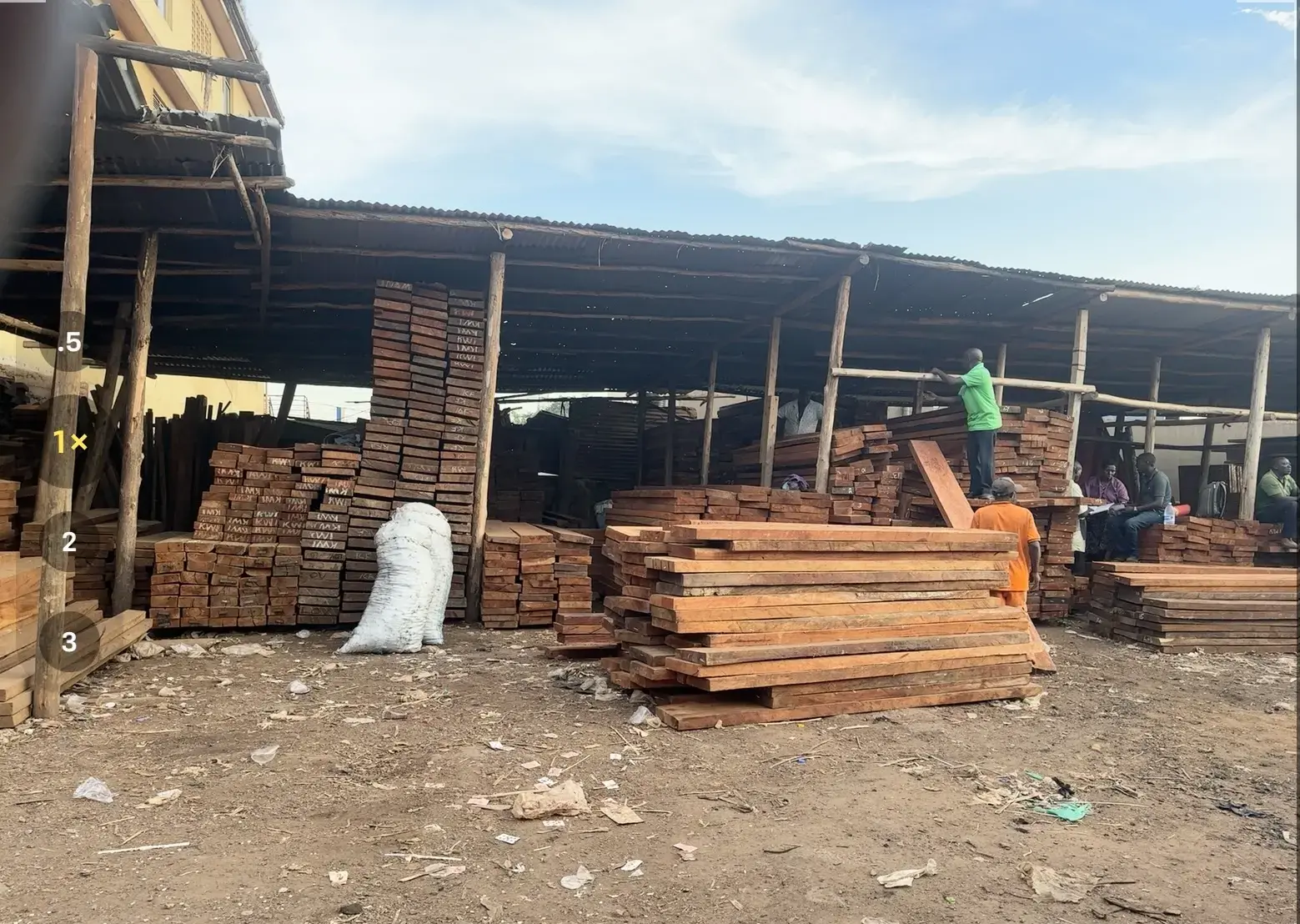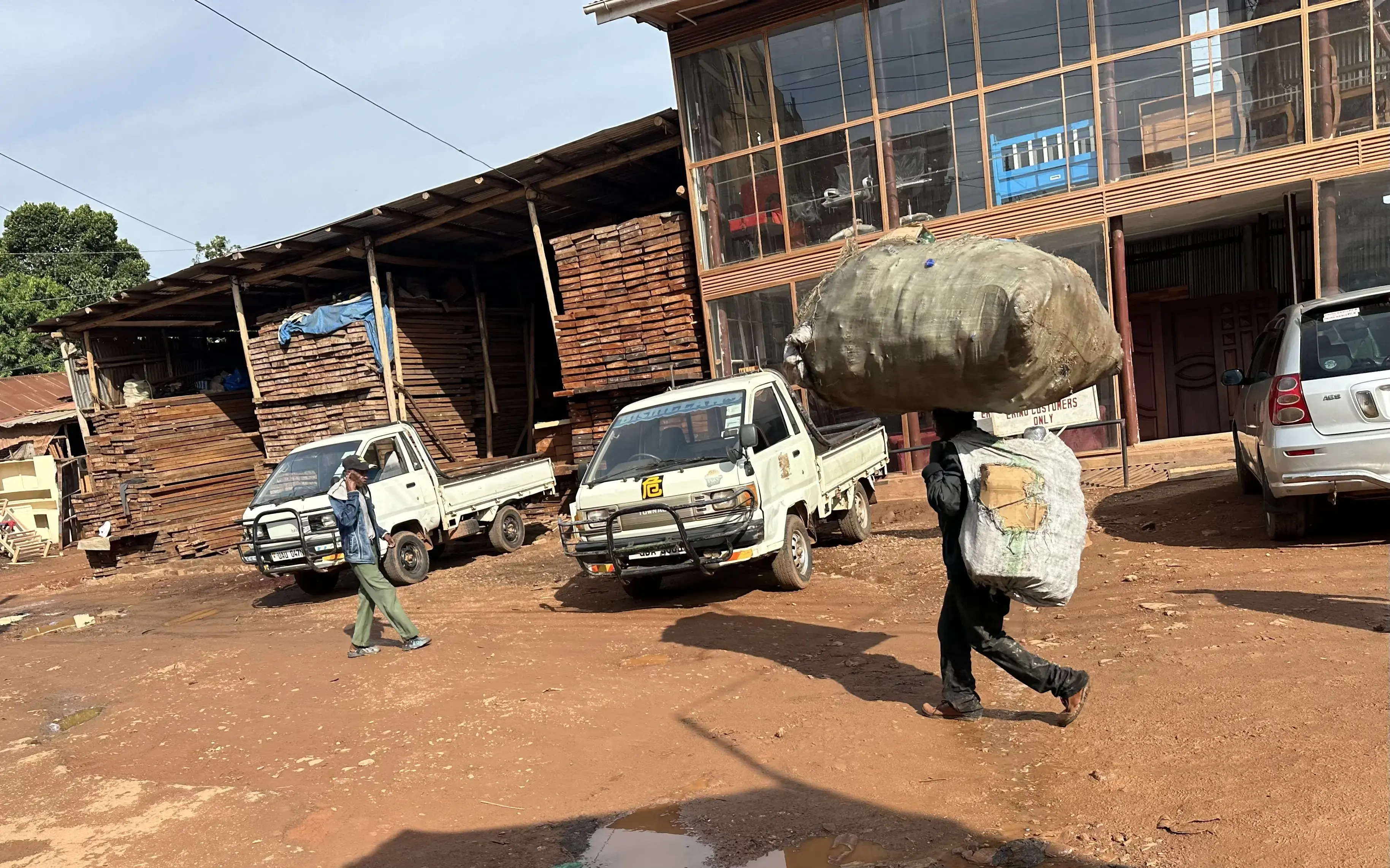
We talk to manufacturers and officials in Kampala to observe the end users of smuggled Democratic Republic of Congo hardwood — furniture makers who import more than $1m worth of timber a year.
This is part 3 of a 4-part series
Ugandan prisoners hone African mahogany into furniture at a government-run business that takes pride of place at the Uganda Prisons furniture showroom at the Uganda Manufacturers’ Association (UMA) showgrounds in Kampala.
At the Uganda Prisons headquarters, spokesperson Frank Baine proudly points to chairs in his office, while tapping a table.

As a nonprofit journalism organization, we depend on your support to fund more than 170 reporting projects every year on critical global and local issues. Donate any amount today to become a Pulitzer Center Champion and receive exclusive benefits!
“It’s one of the most durable types of timber; these chairs can go for 100 years, guaranteed,” he says, adding: “Furniture made from mahogany can withstand any tension or pressure.”
The institution supplies furniture to government offices, including the office of President Yoweri Museveni and parliament.
Unchecked permits
Senior Superintendent of Prisons Benjamin Bunkwaitse Ngabwah, who is in charge of industries and production, says the mahogany is sourced from the DRC. Still, they have no interest in conducting due diligence on whether the timber is sourced through the right procedures.
“Once the supplier delivers to our stores, and we see it’s timber, we count the number of pieces and pay the supplier,” says Ngabwah.
Uganda prisons contract suppliers who deliver mahogany to their storeroom. Their suppliers have trading permits allowing them to transport timber, but prison authorities do not check the permits, saying that the wood has already been checked many times along the road at security checkpoints.
“As long as timber comes and reaches our stores, that is all [we care about],” he says.
No paper trail
Leading furniture companies in Kampala also rely on mahogany that is smuggled outright from the DRC or transported with fake documents or no documents, as this four-part investigation details.
There is little attention on how the timber is sourced among end users. And those who claim to care have no evidence that the timber has passed through legal channels.
"You can never get good results … by raiding these places."
Bob Kazungu, Uganda’s acting assistant commissioner for forestry
In Ndeeba, the largest timber market in Kampala, The Africa Report approached Baltarazi Muramuzi, a leader among the Congo timber dealers. He said stories of suppliers moving timber to Kampala are not for sharing with the media because some don’t pay taxes.

Once timber arrives at the markets in Kampala and furniture workshops, it is no longer illegal, due to loopholes in the law, according to Professor Abwoli Banana of Makerere University. Indeed, no one wants to inspect it.
The Uganda Revenue Authority (URA) says it can only enter company premises if it has adequate information of wrongdoing.
Bob Kazungu, Uganda’s acting assistant commissioner for forestry at the Ministry for Water and Environment, argues it is counterproductive to inspect furniture companies and timber dealers to check their documents.
“You can never get good results as [law] enforcement agencies by raiding these places because … they will provide you with forged documents, and you will go to court and spend all your time arguing,” he says.
Hardwood, Uganda furniture favourite
Despite saying that they try as much as possible to ensure that they deal with legitimate timber suppliers, Gideon Mayanja, factory manager at Erimu Company Limited, which has operated for 25 years in Uganda, says there are certain things they cannot confirm.
“We can’t ensure that a [supplier] has paid tax fully,” he says. “That is not easy to tell.” Paying tax is a prerequisite for importing timber into the country.
Mayanja says they encourage timber suppliers to “use the right procedures” when sourcing wood from the DRC.

Master Wood Investments, a company that has produced furniture for more than three decades, largely relies on hardwood.
“I have never asked about this,” production manager Jean Mary Munabi says when asked if they require suppliers to produce documents of the timber’s source.
When a supplier delivers timber, “we check whether the measurements are okay and the quality. We offload and put it in our stores,” he says.
To protect Uganda’s environment and to avoid any issues with the government, Abraham Opio, furniture production manager at Nile House, a large Ugandan furniture manufacturer, says they rely on imported timber from the DRC and South Sudan.
We ensure that suppliers have lumbering permits.
Footsteps Furniture marketing executive Frank Nsubuga
He says the company has put in place stringent measures requiring all their suppliers to produce documents from the URA confirming that the timber is imported legally, as well as forestry documents from the countries where it’s imported from confirming that the wood was legally harvested.
The market wants mahogany, and Congo timber is of the highest quality, according to Footsteps Furniture marketing executive Frank Nsubuga, who serves high-profile and government customers.
“We ensure that suppliers have lumbering permits,” he says, adding that through checks, the company ensures that they don’t buy endangered species and also undergo due diligence.
Museveni, cheerleader of ‘Ugandan’ furniture
Uganda banned logging indigenous species from its forests since the 1990s and the ban has never been lifted, leading its furniture industries to rely on hardwood from Congo. Uganda views DRC forests as a source of wood, while revenue is generated from taxes on imported wood and its ecosystem plays a vital role in the country’s rainfall patterns.
While Uganda pays lip service to protecting the Congo Basin, the reality is much more apparent.
Vice President Jessica Alupo represented Museveni at the three-basin summit — Amazon, the DRC and Borneo Mekong Southeast Asia — in Congo Brazzaville in October 2023.
Her impassioned speech on climate change and Uganda’s affiliation with the Congo Basin contrasts with President Museveni’s actions.
Museveni has created a sustained drive to promote the local furniture industry over the past eight years. In 2016, he commended Uganda prisons for making top-quality furniture and promised to issue a directive ensuring “government departments, even State House [president’s residence] … to buy furniture from prisons.”
The president provided the prisons with financial support to buy new machines and revamp furniture workshops to prepare for the anticipated market boom, head of Uganda prisons Johnson Byabashaija said in an interview with a local publication in 2019.
"For the office of the president, I have delivered an order worth about USh50m."
Senior Superintendent of Prisons Benjamin Bunkwaitse Ngabwah
“The president has given us some capital and directed us to produce furniture for the ministries,” Byabashaija said. “The furniture you see in parliament was made by the Uganda Prisons Service. Most of the furniture in the president’s office is made by the prison. Those big maroon chairs you see during important ceremonies, are made by Uganda Prisons Service.”
The president’s 1 July 2019 directive, issued by the then-permanent secretary for the ministry of finance, called on “accounting officers, heads of state enterprises, public corporations and heads of state parastatals to procure all their furniture requirements from national and or resident providers engaged in [the] manufacturing process.”
Ngabwah has pinned the letter to a bulletin board in his office. And orders for furniture from government agencies have been flowing in.
“For the office of the president, I have delivered an order worth about USh50m [roughly $13,000]. I have delivered an order from the parliament of Uganda. We have an order from the National Drug Authority of about USh23m [roughly $6,000] and more,” says Ngabwah.
The numbers don’t add up
Although there is plenty of Congolese timber in Kampala, data on Uganda’s official timber imports from the country are scanty and unreliable given the under-declaration of what is officially imported by dealers.
According to UN Comtrade, a global trading platform, 88,847 tonnes of mahogany worth $3.2m entered the country in 2020 and 2021. There was no data for 2022. According to the statistics, no other species were imported besides African mahogany.
The URA provided data for a slightly different period: 2,561 entries of mahogany from the DRC were recorded between July 2019 and June 2022, worth USh8.9bn (about $2.3m). Its quantity is hard to compute because kilograms and cubic metres are mixed in the entries. Additionally, there is no quantity for 89 of the entries. The URA describes this as human error.
At the time of the interview with The Africa Report, Erimu bought each piece of timber for USh200,000 (roughly $52 for one piece), although the prices fluctuate.
This means that the company spends about $460,000 on timber a year; 95% of it being spent on Congolese timber.
Erimu’s Mayanja says that the company utilises at least 14 trucks of timber yearly at a minimum guess. But the number can increase to 20 trucks depending on furniture demand. A truck normally delivers 600-700 pieces of timber.
Ngabwah said that from May 2022 to November 2023 the prison had spent USh2bn on timber, which comes to about $530,000 if you factor in the exchange rate.
“I would say mahogany makes up 80%,” he says, referring to the prison wood order. That would mean that around $420,000 was spent on purchasing Congolese timber.
At Nile House, Opio said they use no less than 3,000 pieces of mahogany per year, which translates to $156,000, basing the price on the same 2023 benchmark. According to our calculations, three companies spend more money on imports than what is captured in the URA’s tax database.
Unreliable statistics
Any statistical evidence showing that the local furniture industry consumes more timber than officially imported would be a clear indication “that they are consuming illegal wood,” says forestry assistant commissioner Kazungu.
Perhaps, he says, an argument can be made that “there seems to be much more [timber] volume than what is reported.”
Kazungu hastens to add that there is a need to be “sure that the volume of wood reported in the FAO statistics resonates with the wood that we are consuming as a local furniture industry.” If it’s not, then it’s not right, he says.
Professor Banana says data from the URA is not reliable. According to statistics from the URA and UN Comrade, Uganda has only imported mahogany and two shipments of iroko, another rare hardwood, worth $9,989 over the past three years.
I have never seen a dataset that looks like something decent
Paul Omar Cerutti, the DRC office at the Center for International Forestry Research and World Agroforestry
Another possible indicator of illegal timber on the market in Kampala is the species on offer. According to statistics from URA, Uganda only imported mahogany and two shipments of iroko between June 2019 and June 2022. However, furniture companies and timber dealers offer other species from the DRC.
Kazungu says it could be a problem of labelling, which is usual in the region. “Not many people understand the species … species could likely be misrepresented,” he says.
In addition to timber without permits, a Center for International Forestry Research and World Agroforestry (CIFOR-ICRAF) study found that species were being misdeclared, leading to timber being improperly taxed or not at all.
Paul Omar Cerutti, head of the DRC office at the Center for International Forestry Research and World Agroforestry, says that Uganda timber import datasets are undependable.
“I have never seen a dataset that looks like something decent,” he says. “It is clear that the legality of timber traded from the DRC and its potential negative impacts on our common environment are less important to importing eastern African countries than the benefits of filling their internal demand for timber.”







